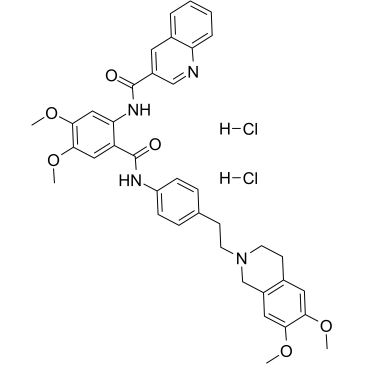| Description |
Tariquidar dihydrochloride (XR9576 dihydrochloride) is a potent and specific inhibitor of P-glycoprotein (P-gp) with the high affinity (Kd=5.1 nM)[1].
|
| Related Catalog |
|
| Target |
Kd: 5.1 nM (P-gp)[1]
|
| In Vitro |
Tariquidar (XR9576) is a potent modulator of P-gp mediated [3H]-Vinblastine and [3H]-Paclitaxel transport as it increases the steady-state accumulation of these cytotoxics in CHrB30 cells to levels observed in non-P-gp-expressing AuxB1 cells (EC50=487±50 nM). [3H]-Tariquidar binds to CHrB30 membranes with the highest affinity (Kd=5.1±0.9 nM, n=7) and a binding capacity (Bmax) of 275±15 pmol/mg membrane protein. In contrast to the parental cell line, the accumulation of [3H]-Vinblastine is increased in a dose-dependent fashion by the modulators Tariquidar (EC50=487±50 nM). The MDR modulator Tariquidar is able to inhibit 60-70% of the vanadate-sensitive ATPase activity, with potent IC50 value of 43±9 nM[1]. Tariquidar (XR9576) potentiates the cytotoxicity of several drugs including Doxorubicin, Paclitaxel, Etoposide, and Vincristine; complete reversal of resistance is achieved in the presence of 25-80 nM XR9576. Tariquidar is a potent inhibitor of photoaffinity labeling of P-gp by [3H]Azidopine implying a direct interaction with the protein[2].
|
| In Vivo |
In mice bearing the intrinsically resistant MC26 colon tumors, coadministration of Tariquidar (XR9576) potentiates the antitumor activity of Doxorubicin without a significant increase in toxicity; maximum potentiation is observed at 2.5-4.0 mg/kg dosed either i.v. or p.o. In addition, coadministration of Tariquidar (6-12 mg/kg p.o.) fully restores the antitumor activity of Paclitaxel, Etoposide, and Vincristine against two highly resistant MDR human tumor xenografts (2780AD, H69/LX4) in nude mice. Tariquidar is found to also significantly potentiate the antitumor activity of doxorubicin against s.c. MC26 tumors in vivo[2].
|
| Cell Assay |
Cells (EMT6 AR1.0 8×102/well; A2780 5×103/well; 2780AD 6×103/well) are seeded into 96-well plates. After ~4 h, varying concentrations of Tariquidar are added, and cells are incubated for an additional 4 days (EMT6 AR1.0) or 6 days (2780AD) before quantification of cell growth and calculation of IC10 values (concentration resulting in 10% inhibition of cell growth)[2].
|
| Animal Admin |
Mice[2] MC26 tumor slurry is implanted s.c. in BALB/c mice (day 0). The animals are then randomized, 24 h later, into groups of 15-18 and treated once with various regimens. Tariquidar or vehicle is administered either i.v. via a lateral tail vein or p.o. with Doxorubicin (5 mg/kg) or vehicle i.v. The modulator is administered either i.v. at 2-4 mg/kg (10 mL/kg) at the same time as Doxorubicin or p.o. at 2-8 mg/kg (10 mL/kg) 1 h before the Cytotoxic drug. GG918 is administered p.o. 1 h before doxorubicin. All of the animals are weighed twice weekly. The animals are killed by cervical dislocation on day 14, and the tumors are excised and weighed. The data are analyzed by Student’s t test. Rats[2] Male CD rats (3 animals per time point) are dosed i.v. with paclitaxel alone [15 min infusion at 10 mg/kg in Tween 80:ethanol:5% dextrose (5:10:85% v/v/v)] or in combination with Tariquidar (10 mg/kg). Tariquidar is administered as a bolus (i.v.) dose 15 min before infusion of Paclitaxel. Blood samples are collected by cardiac puncture using heparinized syringes at various times between 0.083 and 48 h and are centrifuged to prepare plasma, which is stored at −20°C until analysis. Paclitaxel concentration in plasma samples is measured by a LC-MS/MS assay.
|
| References |
[1]. Martin C, et al. The molecular interaction of the high affinity reversal agent XR9576 with P-glycoprotein. Br J Pharmacol, 1999, 128(2), 403-411. [2]. Mistry P, et al. In vitro and in vivo reversal of P-glycoprotein-mediated multidrug resistance by a novel potent modulator, XR9576. Cancer Res, 2001, 61(2), 749-758.
|
